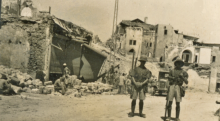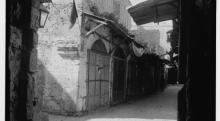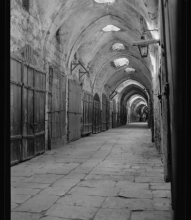While land theft was the wide agenda of the British Mandate in Palestine, it also stole livelihood of which had formed a part of the identity of thousands of Palestinians. Despite the gaping hole of the loss of land that shaped Palestinian national identity for the following decades, it became at the same time a renewed cause for resistance, which continued to galvanize revolutions and Intifadas from 1936 until today.
Palestinians entered the second decade of the last century exhausted by natural disasters and global crises. Locusts devoured farmland in 1915, and in 1927 a terrible earthquake shook the country. Two years later, Palestinians felt the effects of an economic collapse resulting from the Great Depression, which lasted for many years after.1

Blocked-up street in Nablus, choked by fallen houses affected by 1927 earthquake
These successive crises fueled the British Mandate's policies of counterinsurgency. The administration levied exorbitant taxes upon Palestinians ever since it took control over the country, collecting the taxes in the Egyptian currency without taking into consideration the prevailing miserable economic conditions.2 British authorities also tightened the screws on farmers by preventing them from using the railway to ship their crops, which in turn led to the crops' overaccumulation and a decrease in their price. As a result farmers were unable to pay their taxes.
But this deliberate policy was not isolated to targeting tax funds. Palestinians were forced into mortgaging their own lands to Jewish moneylenders, and when the time for payment was exceeded, land ownership would be transferred to the moneylenders by court order.3
Land sale to Jews marked this era, legally and politically expedited by the British government to the point that it modified existing land laws to facilitate Jewish control over Palestinian land. Those included reforms to lands categorized as vacant, non-arable, and subject to expropriation, limiting Palestinian ownership of land and enabling British expropriation of large tracts of land belonging to peasants. Taking advantage of legal loopholes, the British deliberately sold land to Jewish companies and settlers, while Palestinians were unable to resist such systematic looting.4
With the continuing flow of Jewish immigration to Palestine, the Mandate authorities only increased its land theft under the aegis of the new property laws, and land ownership increasingly found itself in Jewish hands. On top of that, the Jewish Agency specialized in buying hundreds of thousands of dunums from two Arab non-Palestinian owners, enabling it to purchase the lands of Marj Ibn Amer and Wadi al-Hawarath. After purchasing land from Arab owners, the Agency intensified its work to purchase land from the Palestinians themselves.5
Britain did not stop at transferring Palestinian land to Jewish owners, fighting Palestinians for their daily provisions and pushing them into unemployment. These policies contributed to the economic crisis which befell Palestine6, reaching its zenith with the registration of over 12,000 unemployed Palestinians by the end of 1930.7 Many farmers were forced to turn to unskilled and cheap forms of labor, including cleaning and working in cigarette and tobacco companies.8
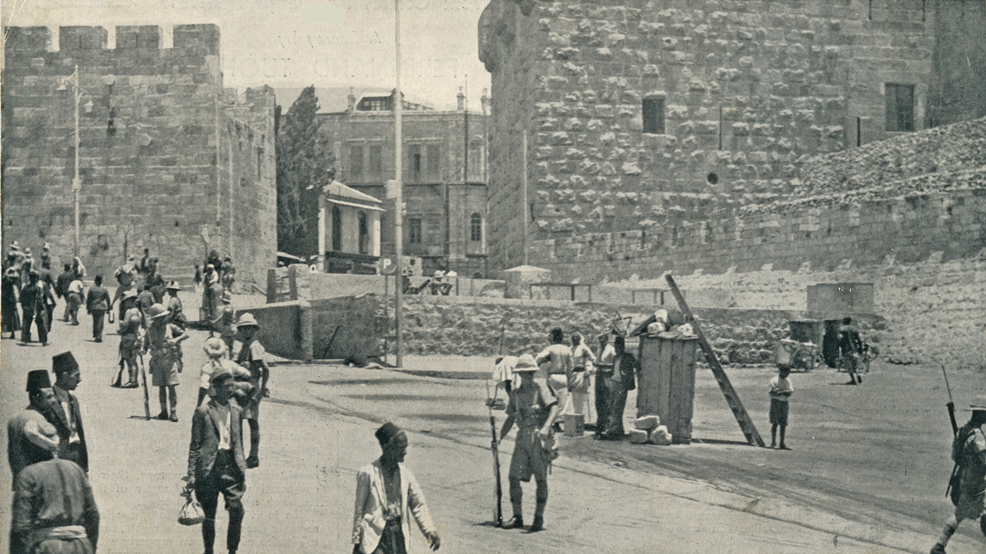
British Mandate soldiers control access to the Old City in Jerusalem in 1936.
The Mandate authorities' unilateral decisions and clear favoring of Zionist forces in Palestine led to the growth of the Jewish economy at the expense of the owners of the land. Coupled with poor management and coordination, and the weaknesses of the Palestinian leadership, the British granted the Zionists all the privileges that enabled them to seize the wealth of the country. This seizure was carried out through the acquisition of large companies and projects, such as the Palestine Electricity project, the drainage of the Houla Lake project, and the Tel Aviv port.
By the mid-1930s, Palestinians reaching their breaking point after British colonialism and Zionist colonization stripped them of their means of survival. This set the stage for the outbreak of revolution.
Peasants in Revolt
Throughout the Mandate years, peasants and farmers were struck hard after the systematic dispossession of their lands. Unemployed, unable to provide for their families, they revolted against colonial policies.
Palestinians underwent successive periods of revolutionary upheaval starting in the 1920s. These acts of revolt were instigated and implemented by the poor and peasants, and revolutionary leaders came from this class ever since the Qassam revolution. Shaykh Izzeddin al-Qassam who was killed in the beginning of the revolution, was a peasant and vendor in Haifa. Ali Mahmoud Zarour, one of the first Qassam followers, was also a peasant and a vendor. Mohammed Salah, who was killed in the Battle of Buya in Nablus in 1938, was a peasant, and then a peddler. Other examples from the leadership include Abu Ibrahim al-Kabir, who was the owner of a small store that sold sacks, and Yusef Abu Durra and Shaykh Farhan al-Saadi.9
These leaders and other revolutionaries worked to meet the needs of the revolution by using their own finances. They also worked to collect funds through monthly subscriptions and voluntary donations. Every candidate for the Qassam membership for example had to secure his personal weapon at his own expense. It can even be said that the revolutionaries were spending their own money on their political activity.10
The peasants and poor made up more than 90 percent of the revolutionaries of the Palestinian Revolution They were able to declare a revolution that was later joined by all segments of society, during which they managed to escalate their confrontations against the British and the Jews. Early on in the revolution, Palestinians realized the effectiveness of economic resistance and its importance in tipping the scales in their favor and achieving victories on the ground. This was especially true given the large military gap that put them at the bottom of the pyramid in terms of strength and the ability to wage a direct military war. Consequently, they declared a comprehensive strike that paralyzed all economic facilities, having little left to lose by already being dispossessed of most of their land and property.
With the outbreak of the revolution and the intensification of fighting against British and Jewish forces, the Palestinians began to carry out operations that targeted the resources and properties of the British and Jewish forces alike. The operations were in retaliation for the British destabilization of Palestinian economic capabilities, and sought to undermine British military supremacy on the ground. The strike directly halted governmental, agricultural and construction work. The port was also stopped in Jaffa and Jewish factories were halted by a strike by Arab workers in stone quarries.
The operations of the revolutionaries undertook strategic objectives, sabotaging transportation to the point that only British and Jewish transport remained operational with the beginning of the strike began.11
Acts of sabotage against crops and bush were carried out on the popular level, resulting in the burning of 80,000 citrus trees, some 62,000 fruit trees, 64,000 forest trees, and 4,000 acres of other crops, causing the British government losses of about 5.3 million pounds.12 Sporadic operations hit a number of major economic sites and installations, including railways and oil pipelines, and as of mid-May, tourism in Palestine was completely suspended.13
These attacks struck at the economic foundations of the British and Jewish presence in Palestine, upsetting the balance that colonialism counted upon while Palestinians were starving. It also caused an imbalance in power, even for a short time, at the expense of the enemy, which had fortified itself over many years by military force. This was evidenced by an official British statement describing the misery in which their Mandate was engulfed at the time.
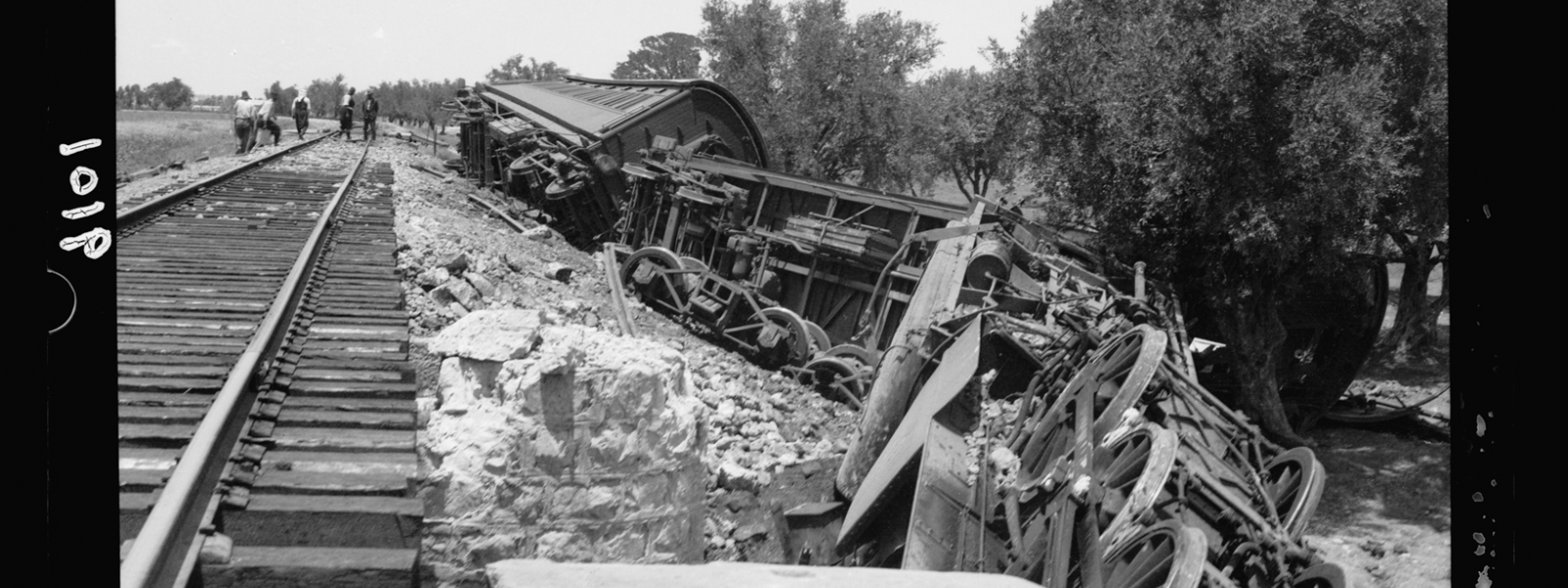
“The activities of these armed gangs included repeated attempts to paralyze transportation, cutting off telegraph and telephone lines, derailing trains, and trying to prevent the movement of traffic on public roads. This has caused great material damage, which has done massive harm to the economy of the country. Several attempts have been made to destroy the Haifa-Iraq oil pipeline and ignite the oil flowing from it. One of the strike's important results was the closure of the Jaffa port effectively, although fortunately, the port of Haifa has so far been minimally affected.”14
SELECTED BIBLIOGRAPHY
- 1Nakhleh, Kamel Mahmoud. Filastin wa al-Intidab al-Britani [Palestine and the British Mandate]. Beirut: 1974, p. 27.
- 2Al-Jundi, Radwan. Siyasat al-Intidab al-Britani al-Iqtisadiyya fi Filastin 1922-1939 [The Economic Policies of the British Mandate in Palestine 1922-1939]. Amman: Dar al-Karmal, 1986, p. 17.
- 3Ibid, p. 18.
- 4Yassin, Abdul-Qader. Thawrat 1936 al-Wataniyeh al-Filastiniyya: Ma'ali Ahmad Ismat, Waqa'i al-Thawra [The Palestinian National Revolution: Ahmed Ismat, Proceedings of the Revolution]. Cairo: Markaz al-Mahrousa lil Nashr wa al-Khadamat al-Sahafiyya wa al-Ma'lumat, 2007, p. 181.
- 5Kabaha, Mustafa. Thawrat 1936 al-Kubra: Dawafi'uha wa In'ikasatuha [The Great Revolt of 1936: its Motivations and Implications]. Nazareth: al-Quds Library and Publications, 1988, pp. 26-27.
- 6Himadeh, Said. The Economic System in Palestine. Beirut: The American Printing Press in Beirut, 1939.
- 7Kayyali, Abdul Wahhab. Tarikh Filastin al-Hadith [The Modern History of Palestine]. Beirut: al-Mu'assasa al-Arabiyya lil Dirasat wa al-Nashr, 1999, p. 223.
- 8Kanafani, Ghassan. The 1936-1939 Revolt: Background, Details and Analysis.” Palestinian Agency for Journalism and Publications. Jerusalem: Nasser Printing Press, p. 30.
- 9Hassouneh, Khalil Ibrahim. Al-Thawra al-Sha'biyya al-Filastiniyya: Thawrat 1936 Namudhajan [The Popular Palestinian Revolt: the Model of the 1936 Revolt]. Gaza: al-Markaz al-Qawmi lil-Dirasat wa al-Nashr, 2001, pp. 55-56.
- 10Kanafani, Ghassan. The 1936-1939 Revolt, pp. 59-60.
- 11Khalifeh, Ahmad. Al-Thawra al-Arabiya al-Kubra fi Filastin 1936-1939: al-Riwaya al-Isra'iliya al-Rasmiya [The Great Arab Revolt in Palestine 1936-1939: An Official Israeli Account]. Beirut: Institute for Palestine Studies, 1989, p. 18.
- 12History of the Haganah. Volume 2, Part 2. 1959, p. 650.
- 13Yassin, Palestinian National Revolution, p. 99.
- 14Al-Asali, Bassam. Thawrat Shaykh Izzeddin al-Qassam [The Revolution of Sheikh Shaykh Izzeddin al-Qassam]. Beirut: al-Diwan, 1991, p. 157.
